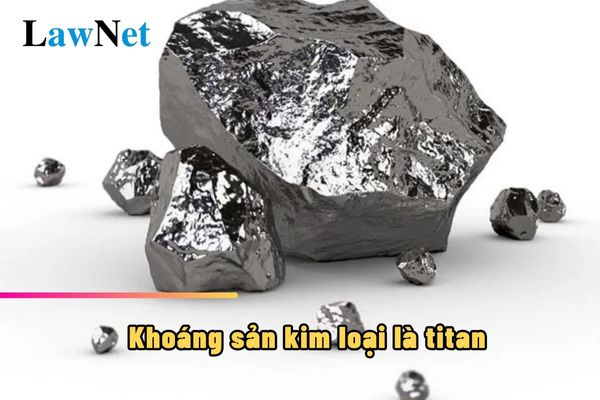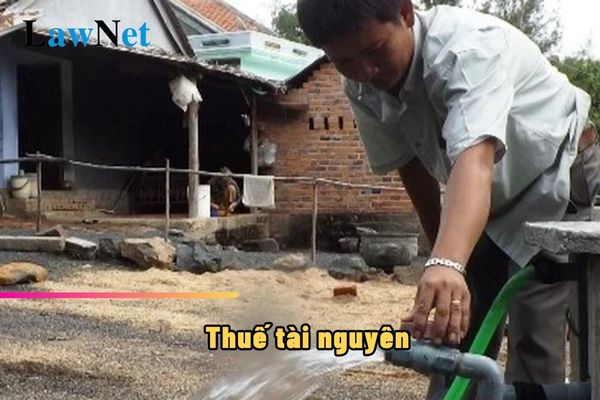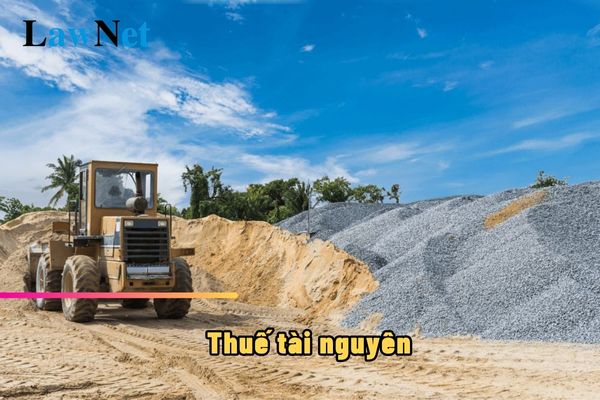Are metallic minerals which are titanium subject to severance tax in Vietnam?
Are metallic minerals which are titanium subject to severance tax in Vietnam?
Based on Article 2 of the 2009 Law on severance tax (amended by Clause 1, Article 4 of the 2014 Law on Amendments to Laws on Taxation), the following entities are subject to tax:
- Metallic minerals.
- Non-metallic minerals.
- Crude oil.
- Natural gas, coal gas.
- Products from natural forests, excluding animals.
- Natural aquatic resources, including marine plants and animals.
- Natural water, including surface water and groundwater, excluding natural water used for agriculture, forestry, fishery, and salt production.
- Natural bird nests.
- Other resources as regulated by the Standing Committee of the National Assembly.
Additionally, based on the tax rate framework for severance tax in Article 7 of the 2009 Law on severance tax, titanium falls under the category of metallic minerals.
Thus, according to the above regulations, metallic minerals, such as titanium, are taxable resources. Therefore, metallic minerals which are titanium are subject to severance tax.

Are metallic minerals which are titanium subject to severance tax in Vietnam? (Image from the Internet)
What is the severance tax rate for metallic minerals which are titanium in Vietnam?
Based on the tax rate framework for severance tax in Article 7 of the 2009 Law on severance tax, the tax rate framework is as follows:
-Severance tax rate framework is regulated as follows:
| Group | Name | (%) |
| I | Metallic minerals | |
| 1 | Iron, manganese | 7 - 20 |
| 2 | Titanium | 7 - 20 |
| 3 | Gold | 9 - 25 |
| 4 | Rare earth elements | 12 - 25 |
| 5 | Platinum, silver, tin | 7 - 25 |
| 6 | Wolfram, antimony | 7 - 25 |
| 7 | Lead, zinc, aluminum, bauxite, copper, nickel | 7 - 25 |
| 8 | Cobalt, molybdenum, mercury, magnesium, vanadium | 7 - 25 |
| 9 | Other metallic minerals | 5 - 25 |
| II | Non-metallic minerals | |
| 1 | Land extracted for leveling, construction | 3 - 10 |
| 2 | Stone, except for lime and cement production; gravel; sand, except for glass sand | 5 - 15 |
| 3 | Land for brick production | 5 - 15 |
| 4 | Granite, refractory clay | 7 - 20 |
| 5 | Dolomite, quartzite | 7 - 20 |
| 6 | Kaolin, mica, technical quartz, glass sand | 7 - 15 |
| 7 | Pyrite, phosphorite, lime and cement production stone | 5 - 15 |
| 8 | Apatite, serpentine | 3 - 10 |
| 9 | Anthracite coal (underground) | 4 - 20 |
| 10 | Anthracite coal (open-pit) | 6 - 20 |
| 11 | Lignite, fat coal | 6 - 20 |
| 12 | Other types of coal | 4 - 20 |
| 13 | Diamonds, rubies, sapphires | 16 - 30 |
| 14 | Emeralds, alexandrite, precious opal (black) | 16 - 30 |
| 15 | Rhodolite, pyrope, beryl, spinel, topaz | 12 - 25 |
| 16 | Amethyst, cryolite, precious opal (white, fire red), feldspar, turquoise, nephrite | 12 - 25 |
| 17 | Other non-metallic minerals | 4 - 25 |
| III | Crude oil | 6 - 40 |
| IV | Natural gas, coal gas | 1 - 30 |
| V | Products from natural forests | |
| 1 | Wood, Group I | 25 - 35 |
| 2 | Wood, Group II | 20 - 30 |
| 3 | Wood, Group III, IV | 15 - 20 |
| 4 | Wood, Group V, VI, VII, VIII, and other types of wood | 10 - 15 |
| 5 | Branches, tops, roots | 10 - 20 |
| 6 | Firewood | 1 - 5 |
| 7 | Bamboo, rattan, nứa, mai, giang, tranh, and similar | 10 - 15 |
| 8 | Agarwood, ky nam | 25 - 30 |
| 9 | Star anise, cinnamon, amomum, cardamom | 10 - 15 |
| 10 | Other products from natural forests | 5 - 15 |
| VI | Natural marine resources | |
| 1 | Pearls, abalone, sea cucumbers | 6 - 10 |
| 2 | Other natural marine resources | 1 - 5 |
| VII | Natural water | |
| 1 | Natural mineral water, natural hot water, bottled or canned filtered natural water | 8 - 10 |
| 2 | Natural water used for hydroelectric production | 2 - 5 |
| 3 | Natural water used for other production or business purposes | |
| 3.1 | Surface water | 1 - 3 |
| 3.2 | Groundwater | 3 - 8 |
| VIII | Natural bird nests | 10 - 20 |
| IX | Other resources | 1 - 20 |
- Specific tax rates for crude oil, natural gas, and coal gas are determined progressively based on average daily production.
- According to Clause 1 and Clause 2 of this Article, the Standing Committee of the National Assembly stipulates specific tax rates for each type of resource and period, ensuring the following principles:
+ Complying with the list of resource categories and within the tax rate framework set by the National Assembly;
+ Contributing to state management of resources; protecting, exploiting, and using resources rationally, economically, and efficiently;
+ Ensuring state budget revenue and market stability.
Thus, according to the above regulations, the severance tax rate for metallic minerals which are titanium will range from 7% to 20%.
How is the taxable resource quantity determined for metallic minerals which are titanium that are extracted but not sold and are instead used for production?
According to Article 5 of the 2009 Law on severance tax:
* Taxable Resource Quantity
- For resources extracted that can be quantified by number, weight, or volume, the taxable resource quantity is the actual quantity, weight, or volume extracted during the tax period.
- For resources extracted that cannot be quantified by number, weight, or volume due to containing various substances and impurities, the taxable resource quantity is determined based on the quantity, weight, or volume obtained after sorting and classification.
- For resources extracted but not sold and are instead used for production, if the actual quantity, weight, or volume extracted cannot be directly determined, the taxable resource quantity is determined based on the quantity of products produced during the tax period and the standard resource usage per unit of product.
- For natural water used in hydroelectric production, the taxable resource quantity is the electricity quantity sold to the buyer under the purchase contract or the quantity delivered in cases without a purchase contract, determined according to a metering system meeting Vietnamese standards of measurement and quality, confirmed by both seller and buyer or deliverer and receiver.
- For natural mineral waters, hot waters, and water used for industrial purposes, the taxable resource quantity is measured in cubic meters (m³) or liters (l) according to a metering system meeting Vietnamese standards of measurement and quality.
- For manually extracted, dispersed, or intermittently extracted resources, with an estimated annual extraction value below 200,000,000 VND, taxable resource quantity is seasonally or periodically allocated based on the estimated extraction quantity for tax calculation. The Tax Authority collaborates with relevant local agencies to determine the allocated extraction quantity for tax purposes.
Thus, the taxable resource quantity for metallic minerals which are titanium that are extracted but not sold and instead used for production is determined based on the quantity of products produced during the tax period and the standard resource usage per unit of product.





- Are rice and corn harvesters subject to VAT in Vietnam?
- Are agricultural tractors exempt from VAT in Vietnam?
- What is the form of report on operation of tax agent in Vietnam in 2024? Shall a tax agent be suspended from business if it does not submit the operation report?
- VAT rate increased from 5% to 10% for film production services in Vietnam: What are significant amendments in the draft Value-Added Tax Law?
- From January 1, 2025, which entities are exempt from road user charges at toll plazas in Vietnam?
- Who shall receive tax consultation results from the tax advisory councils of communes in Vietnam?
- What is the time limit for imposion of administrative penalties on tax evasion in Vietnam?
- What activities are included in the National E-commerce Week and Online Shopping Day of Vietnam - Online Friday 2024? Are incomes from business on e-commerce platforms taxable?
- What is the timeline for the National E-commerce Week and Online Shopping Day of Vietnam - Online Friday 2024? Do persons selling goods online have to pay taxes?
- What are principles for determining specific levels of road user charges in Vietnam from January 1, 2025?

